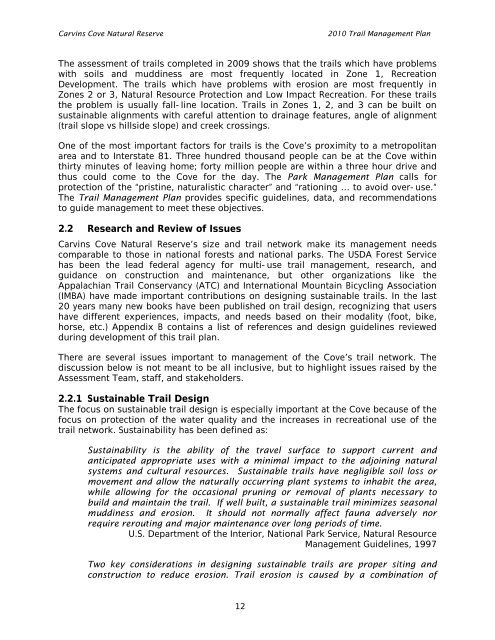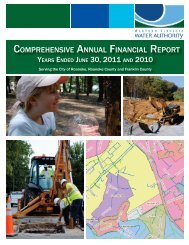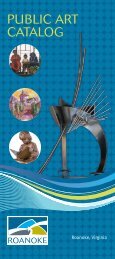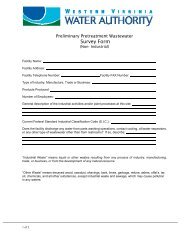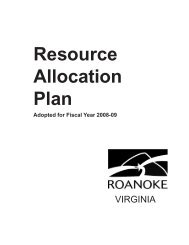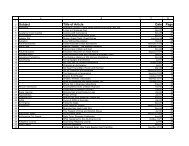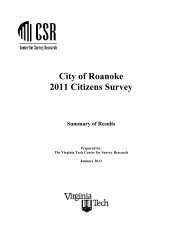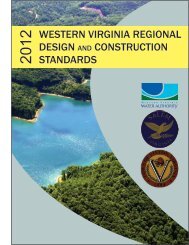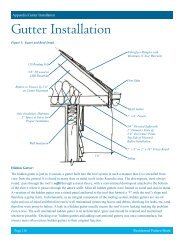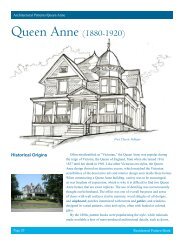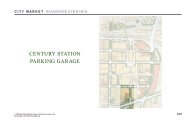Carvins Cove Trail Plan - Roanoke
Carvins Cove Trail Plan - Roanoke
Carvins Cove Trail Plan - Roanoke
Create successful ePaper yourself
Turn your PDF publications into a flip-book with our unique Google optimized e-Paper software.
<strong>Carvins</strong> <strong>Cove</strong> Natural Reserve<br />
2010 <strong>Trail</strong> Management <strong>Plan</strong><br />
The assessment of trails completed in 2009 shows that the trails which have problems<br />
with soils and muddiness are most frequently located in Zone 1, Recreation<br />
Development. The trails which have problems with erosion are most frequently in<br />
Zones 2 or 3, Natural Resource Protection and Low Impact Recreation. For these trails<br />
the problem is usually fall-line location. <strong>Trail</strong>s in Zones 1, 2, and 3 can be built on<br />
sustainable alignments with careful attention to drainage features, angle of alignment<br />
(trail slope vs hillside slope) and creek crossings.<br />
One of the most important factors for trails is the <strong>Cove</strong>’s proximity to a metropolitan<br />
area and to Interstate 81. Three hundred thousand people can be at the <strong>Cove</strong> within<br />
thirty minutes of leaving home; forty million people are within a three hour drive and<br />
thus could come to the <strong>Cove</strong> for the day. The Park Management <strong>Plan</strong> calls for<br />
protection of the “pristine, naturalistic character” and “rationing … to avoid over-use.”<br />
The <strong>Trail</strong> Management <strong>Plan</strong> provides specific guidelines, data, and recommendations<br />
to guide management to meet these objectives.<br />
2.2 Research and Review of Issues<br />
<strong>Carvins</strong> <strong>Cove</strong> Natural Reserve’s size and trail network make its management needs<br />
comparable to those in national forests and national parks. The USDA Forest Service<br />
has been the lead federal agency for multi-use trail management, research, and<br />
guidance on construction and maintenance, but other organizations like the<br />
Appalachian <strong>Trail</strong> Conservancy (ATC) and International Mountain Bicycling Association<br />
(IMBA) have made important contributions on designing sustainable trails. In the last<br />
20 years many new books have been published on trail design, recognizing that users<br />
have different experiences, impacts, and needs based on their modality (foot, bike,<br />
horse, etc.) Appendix B contains a list of references and design guidelines reviewed<br />
during development of this trail plan.<br />
There are several issues important to management of the <strong>Cove</strong>’s trail network. The<br />
discussion below is not meant to be all inclusive, but to highlight issues raised by the<br />
Assessment Team, staff, and stakeholders.<br />
2.2.1 Sustainable <strong>Trail</strong> Design<br />
The focus on sustainable trail design is especially important at the <strong>Cove</strong> because of the<br />
focus on protection of the water quality and the increases in recreational use of the<br />
trail network. Sustainability has been defined as:<br />
Sustainability is the ability of the travel surface to support current and<br />
anticipated appropriate uses with a minimal impact to the adjoining natural<br />
systems and cultural resources. Sustainable trails have negligible soil loss or<br />
movement and allow the naturally occurring plant systems to inhabit the area,<br />
while allowing for the occasional pruning or removal of plants necessary to<br />
build and maintain the trail. If well built, a sustainable trail minimizes seasonal<br />
muddiness and erosion. It should not normally affect fauna adversely nor<br />
require rerouting and major maintenance over long periods of time.<br />
U.S. Department of the Interior, National Park Service, Natural Resource<br />
Management Guidelines, 1997<br />
Two key considerations in designing sustainable trails are proper siting and<br />
construction to reduce erosion. <strong>Trail</strong> erosion is caused by a combination of<br />
12


